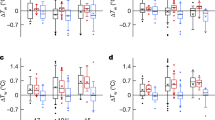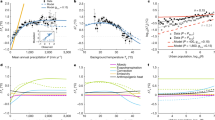Abstract
Heat stress (HS) is a leading cause of weather-related human mortality. As temperatures continue to increase due to climate change, HS is expected to worsen. HS can be magnified in urban areas because of the urban heat island effect. We use an urban canyon model coupled to a land surface model to quantify present-day and projected mid-21st century rural and urban HS for boreal summer over the U.S. and southern Canada and examine the effects of three urban density classes on HS. Five indices of HS are implemented in the model [the NWS Heat Index (HI), Apparent Temperature (AT), Simplified Wet Bulb Globe Temperature, Humidex, and Discomfort Index]. The present-day urban-rural contrast in HS differs according to which index is used. The HI and Humidex have higher urban-rural HS for all density classes than defined by temperature alone. Future urban HS is amplified by 0.5–1.0 °C for the AT, HI, and Humidex compared to temperature alone. For four cities examined in further detail, climate change by mid-century increases the number of high HS days and nights in both rural and urban areas, the magnitude being highly dependent on HS index, urban density class, and each city’s climatic setting. Houston exhibits noteworthy mid-century increases in high heat stress nights, with more than half of summer nights qualifying as high HS in not only urban areas but also rural areas, indicating the need to consider vulnerability and adaptive capacity of both rural and urban populations in the context of climate change.





Similar content being viewed by others
References
CDC (Centers for Disease Control) (2006) Heat-related Deaths---United States, 1999–2003, Mortality and Morbidity Weekly Report published by the Centers for Disease Control, July 28, 2006/55(29):796–798 http://www.cdc.gov/mmwr/preview/mmwrhtml/mm5529a2.htm
Conti S, Meli P, Minelli G et al (2005) Epidemiologic study of mortality during the summer 2003 heat wave in Italy. Environ Res 98:390–399
Delworth T, Mahlman J, Knutson T (1999) Changes in heat index associated with CO2-induced global warming. Clim Change 43:369–386
Diffenbaugh NS, Ashfaq M (2010) Intensification of hot extremes in the United States. Geophys Res Lett 37, L15701. doi:10.1029/2010GL043888
Epstein Y, Moran DS (2006) Thermal comfort and the heat stress indices. Ind Health 44:388–398
Fischer EM, Oleson KW, Lawrence DM (2012) Contrasting urban and rural heat stress responses to climate change. Geophys Res Lett 39, L03705. doi:10.1029/2011GL050576
Gent PR, Danabasoglu G, Donner LJ et al (2011) The Community Climate System Model version 4. J Climate 24:4973–4991
IPCC (2007) In: Solomon S, Qin D, Manning M, Chen Z, Marquis M, Averyt KB, Tignor M, Miller HL (eds) Climate Change 2007: The Physical Science Basis. Contribution of Working Group I to the Fourth Assessment Report of the Intergovernmental Panel on Climate Change. Cambridge University Press, Cambridge, 996 pp
Jackson TL, Feddema JJ, Oleson KW et al (2010) Parameterization of urban characteristics for global climate modeling. A Assoc Am Geog 100:848–865
Lawrence DM, Oleson KW, Flanner MG et al (2011) Parameterization improvements and functional and structural advances in version 4 of the Community Land Model. J Adv Model Earth Syst 3, M03001. doi:10.1029/2011MS000045
Masterson J, Richardson F (1979) Humidex, a method of quantifying human discomfort due to excessive heat and humidity. CLI 1-79, Environment Canada, Atmospheric Environment Service, Downsview, Ontario
Meehl GA, Tebaldi C (2004) More intense, more frequent, and longer lasting heat waves in the 21st century. Science 305:994–997
Moss RH, Edmonds JA, Hibbard KA (2010) The next generation of scenarios for climate change research and assessment. Nature 463:747–756
NOAA NCDC (2012) National Oceanic and Atmospheric Administration, National Climatic Data Center. http://www.ncdc.noaa.gov/oa/ncdc.html. Accessed 10 December 2012
Oke TR (1987) Boundary Layer Climates. 2nd ed, Routledge
Oke TR, Johnson GT, Steyn DG et al (1991) Simulation of surface urban heat islands under “ideal” conditions at night, part 2: diagnosis of causation. Bound-Layer Meteor 56:339–358
Oleson KW, Bonan GB, Feddema J et al (2008) An urban parameterization for a global climate model. 1. Formulation and evaluation for two cities. J Appl Meteorol Clim 47:1038–1060
Oleson KW (2012) Contrasts between urban and rural climate in CCSM4 CMIP5 climate change scenarios. J Climate 25:1390–1412
Rogot E, Sorlie PD, Backlund E (1992) Air-conditioning and mortality in hot weather. Am J Epidemiol 136:106–116
Rothfusz LP (1990) The Heat Index “Equation” (or, more than you ever wanted to know about heat index). Scientific Services Division, NWS Southern Region Headquarters, Fort Worth, TX
Sailor DJ (2010) A review of methods for estimating anthropogenic heat and moisture emissions in the urban environment. Int J Climatol 31:189–199
Sherwood SC, Huber M (2010) An adaptability limit to climate change due to heat stress. Proc Nat Acad Sci 107:9552–9555
Skamarock WC, Klemp JB (2008) A time-split non-hydrostatic atmospheric model for weather research and forecasting applications. J Comput Phys 227:3465–3485
Smith TT, Zaitchik BF, Gohlke JM (2013) Heat waves in the United States: definitions, patterns and trends. Clim Change 118:811–825
Steadman RG (1994) Norms of apparent temperature in Australia. Aust Met Mag 43:1–16
Stone B (2012) The city and the coming climate: Climate change in the places we live. Cambridge University Press, New York
Toronto Public Health (2011) Protecting vulnerable people from health impacts of extreme heat. Toronto, Ontario, 44pp. http://www.toronto.ca/health/hphe
Uejio CK, Wilhelmi OV, Golden JS et al (2011) Intra-urban societal vulnerability to extreme heat: the role of heat exposure and the built environment, socioeconomics, and neighborhood stability. Heath Place 17:498–507
Willett KM, Sherwood S (2012) Exceedance of heat index thresholds for 15 regions under a warming climate using the wet-bulb globe temperature. Int J Climatol 32:161–177
Acknowledgments
This research was supported in part by NASA grant NNX10AK79G (the SIMMER project). K.W. Oleson acknowledges support from the NCAR WCIASP. NCAR is sponsored by the NSF.
Author information
Authors and Affiliations
Corresponding author
Additional information
This article is part of a Special Issue on “Regional Earth System Modeling” edited by Zong-Liang Yang and Congbin Fu.
Rights and permissions
About this article
Cite this article
Oleson, K.W., Monaghan, A., Wilhelmi, O. et al. Interactions between urbanization, heat stress, and climate change. Climatic Change 129, 525–541 (2015). https://doi.org/10.1007/s10584-013-0936-8
Received:
Accepted:
Published:
Issue Date:
DOI: https://doi.org/10.1007/s10584-013-0936-8




